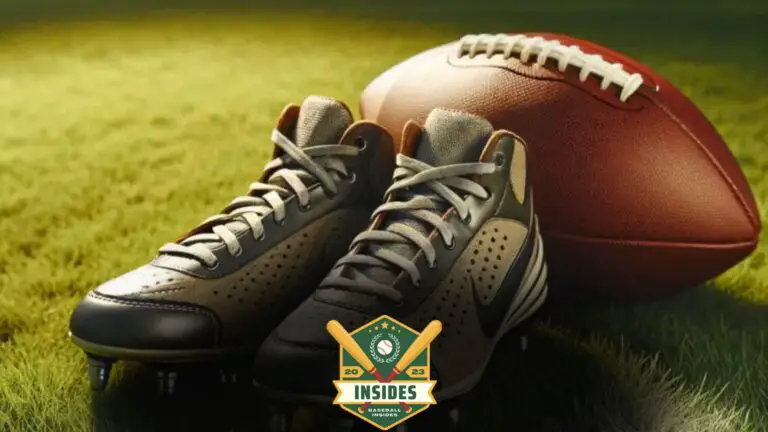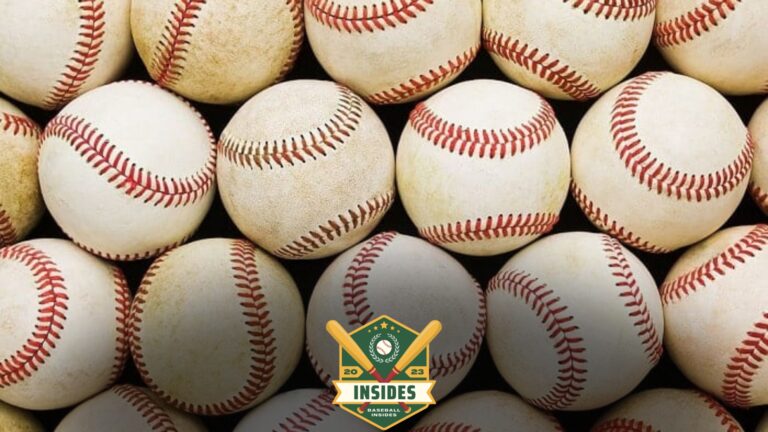
In this article:
Baseball gloves typically have longer fingers and a deeper pocket. Softball gloves are larger with a wider pocket to accommodate the bigger ball.
Understanding the differences between baseball and softball gloves is essential for players to perform at their best.
Both pieces of equipment cater to their respective sports’ unique dimensions and dynamics, tailored to maximize performance and comfort.
Baseball played with a smaller, harder ball, demands a glove that allows for quick transfers and precise catches.
Conversely, softball involves a larger, softer ball, leading to the design of a glove that can handle its size and reduce impact.
Manufacturers craft these gloves with specific materials and stitching patterns, shaping the glove to align with the sport’s requirements.
Selecting the proper glove involves considering webbing, padding, and wrist adjustments, ensuring the player has the right tool for their position and sport.
Grasping the Basics: Baseball vs. Softball Gloves
Grasping the basics of Baseball vs. Softball Gloves opens up a world of detail in sports gear. Players need the right equipment for peak performance.
Understanding the nuances between baseball and softball gloves is key. Let’s explore the size, shape, and position-specific features that set these gloves apart.
Size and Shape Distinctions
The first difference between baseball and softball gloves is their size and shape. Softball gloves typically display a wider and deeper pocket, designed to accommodate the larger softball.
The overall glove size also tends to be larger to match. Baseball gloves, in contrast, have a more compact design with a shallower pocket since baseballs are smaller.
- Baseball gloves: Smaller pocket, tailored for baseball size.
- Softball gloves: Larger pocket, designed for softball dimensions.
Position-specific Features
Another critical aspect is position-specific features. Both baseball and softball gloves are crafted with positions in mind. Catchers, infielders, outfielders, and pitchers each have gloves with unique characteristics.
These features enhance performance and improve handling based on the role’s specific demands.
| Position | Baseball Glove Features | Softball Glove Features |
|---|---|---|
| Catchers | Padded, sturdy, round | Extra padding, larger |
| Infielders | Smaller, shallow pocket | Wider, deeper pocket |
| Outfielders | Longer, deep pocket | Even longer, deeper pocket |
| Pitchers | Closed webbing | Closed webbing, snug fit |
The Historical Evolution of Ball Glove Design
The game of baseball has greatly influenced the design of sports equipment. Ball gloves are no exception.
Over the decades, ball gloves have transformed significantly to enhance player performance and safety.
Let’s explore how baseball and softball gloves have evolved to meet the needs of these distinct sports.
Origins and Adaptations in Baseball
Baseball gloves originated in the late 19th century. Early gloves were simple leather designs that provided minimal protection.
Over time, baseball gloves adapted to offer more padding and webbing and customized fits for different positions on the field.
- 1870s: Gloves were introduced with barehanded play in mind.
- 1920s: Introduction of the webbed pocket design.
- 1950s: Widespread use of heavily padded gloves.
- Today: Position-specific gloves with advanced materials and customizations.
Softball’s Unique Design Requirements
Softball, although similar to baseball, has its own set of unique design requirements for gloves. The ball is larger, and the game has a different pace.
Softball gloves cater to these differences with a larger pocket and a longer, more flexible design.
| Feature | Baseball Glove | Softball Glove |
|---|---|---|
| Size of Pocket | Smaller | Larger |
| Length | Shorter | Longer |
| Flexibility | Stiffer | More Flexible |
Early 20th-century softball gloves were quite like baseball gloves. Innovations specific to softball emerged with the sport’s popularity.
These adaptations made catching the larger ball more manageable and helped players perform better during fast-paced plays.
Key Design Features of Baseball Gloves
Understand the magic behind catching a fast-moving baseball. Baseball gloves have features that make this possible.
Explore the world of these gloves with a close look at what makes them unique. We talk about materials, pocket depth, and webbing patterns.
Materials and Construction
Baseball gloves combine durability and flexibility. This is thanks to the materials they’re made from. Leather is the star here. It’s tough but gets softer with use.
Some gloves also use synthetic materials. These can be lighter and work well for younger players.
- Full-grain leather: Offers strength and durability.
- Steerhide: Tougher and heavier, used by pros.
- Pigskin: Softer and more flexible, great for new players.
Pocket Depth and Webbing Patterns
The pocket of a baseball glove is crucial. It holds the ball once you catch it. A deep pocket helps in the outfield, keeping fly balls secure.
Infielders might go for shallower pockets for quicker throws. Webbing connects the thumb and fingers. It can catch and cushion the ball.
| Position | Pocket Depth | Webbing Type |
|---|---|---|
| Outfield | Deep | Trap-Eze |
| Infield | Shallow | I-Web |
| Catchers | Extra Deep | Closed Web |
| Pitchers | Medium | Closed Web |
Understanding Softball Glove Characteristics
When players step onto the diamond, their gloves act as an extension of their abilities. Softball players, young and old, need the right glove features to perform their best.
Differentiation in glove attributes is vital, especially when considering the specific requirements of softball.
Let’s dive into what makes softball gloves unique, starting with how they vary in size for different age groups.
Sizing Variations for Different Age Groups
Softball gloves come in various sizes to suit players of all ages.
The design and dimensions are tailored, ensuring every player has the right fit for their hand size and age.
- T-Ball: For the youngest players, sizes start around 9 to 10 inches.
- Children: As players grow, glove sizes expand from 10 to 12.5 inches.
- Teens and Adults: Advanced sizes range from 12.5 to 15 inches, providing ample space for player growth and skill development.
Impact of Ball Size on Design
The ball size in softball influences glove design significantly. Softball uses a larger ball than baseball, requiring a larger mitt pocket.
Designers ensure the pocket depth and width accommodate softballs effectively.
| Ball Size | Glove Pocket |
|---|---|
| 11-inch Softballs | Somewhat smaller pockets |
| 12-inch Softballs | Larger, deeper pockets |
Thus, these differences are cosmetic and integral to optimizing player performance and glove longevity.
Choosing the Right Glove for Your Game
Stepping onto the diamond? The glove in your hand is your fielding cornerstone. Your glove is more than gear in baseball and softball—it’s a part of you. It’s crucial to pick a glove that fits your game perfectly.
Whether an outfielder snags fly balls or a catcher guarding home plate, your glove can make or break your play.
Let’s explore how to select the ideal glove to elevate your performance.
Personal Preference and Position Play
Your glove should feel like a natural extension of your hand. Comfort matters most.
Listen to what your hand tells you. Does the glove fit snugly? Can you open and close it with ease? These questions are vital.
- Palm padding absorbs the ball’s impact.
- Wrist adjustments offer a custom fit.
- Pocket size depends on the position you play.
- Material choices affect break-in time and durability.
Different positions require different gloves:
| Position | Features |
|---|---|
| Catcher | Extra padding, durable |
| Infield | Smaller pocket, quicker transfer |
| Outfield | Larger pocket, more reach |
| Pitcher | Closed webbing hides the ball |
Recommendations for Amateurs and Pros
Starting out? Choose a versatile glove. It should be forgiving and aid your learning curve. For the seasoned player, a specialized, high-quality glove is a game-changer.
Amateurs should look for:
- Comfortable fit
- Adjustable wrist strap
- Durable material to withstand errors
Pros require:
- Position-specific features
- Premium materials for longevity
- A glove that complements their skills
Remember—the best glove is the one that feels like part of your hand and matches your playstyle. Test different gloves.
Find the one that boosts your confidence and performance on the field. Now, go ahead and make that game-winning catch!
Maintaining Your Glove Over Time
Like any cherished gear, baseball and softball gloves require ongoing care. Maintaining your glove over time ensures optimal performance and longevity.
Glove care involves breaking in new ones, regular cleaning, and proper preservation. Follow these steps to keep your glove game-ready.
Breaking in New Gloves
To prepare a new glove for the field, it’s crucial to break it in properly. It will shape your hand and soften it for ease of use.
- Use a soft cloth to apply the glove conditioner.
- Play catch to work the leather naturally.
- Place a ball in the glove and wrap it with bands overnight.
Cleaning and Preservation Tips
Clean gloves last longer and perform better. Regular care prevents dirt and moisture damage.
- Wipe dirt with a damp cloth after each use.
- Apply leather cleaner to remove tough grime.
- Condition the leather to retain its pliability and prevent cracks.
- Store in a cool, dry place to avoid mildew and leather warping.
Frequently Asked Questions
How Do You Tell If a Glove is for Baseball or Softball?
Check the size label; softball gloves generally have a larger pattern size. Observe the pocket depth; softball gloves often feature deeper pockets to accommodate larger balls.
Can You Play Softball With a Baseball Glove?
Yes, you can use a baseball glove for playing softball, but it may not perform as well due to size differences in the ball.
Is There a Difference Between Softball and Baseball Catchers Gloves?
Yes, softball catchers’ gloves have a larger pocket and are more padded than baseball catchers’ mitts, catering to the sport’s larger ball.
Is There a Difference Between Baseball and Fastpitch Gloves?
Yes, baseball and fastpitch softball gloves differ. Baseball gloves typically feature a deeper pocket, while fastpitch gloves are designed for a larger ball and offer a snugger fit and more wrist support.
What Defines a Baseball Glove?
Baseball gloves are characterized by smaller pockets and longer, narrower shapes designed specifically for a baseball’s size and game demands.
Conclusion
Understanding the distinctions between baseball and softball gloves is vital for any player. Each sport demands specific designs and features to enhance performance.
We’ve delved into the critical differences — size, fit, and pockets — aiding your selection process. Remember, choosing the right glove can greatly impact your game.
Equip yourself with the best gear and play to your full potential!






